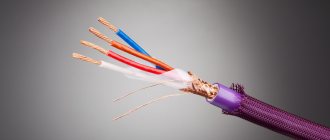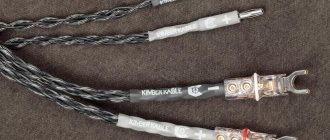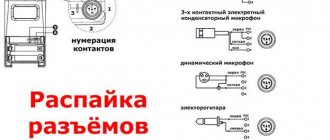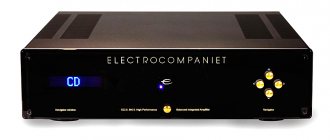New technological capabilities of the equipment that Tchernov Cable uses in cable production allowed the company to make several seemingly insignificant changes to the design of the Classic series analog interconnects. But they seriously affected the quality of the music signal.
We have already talked about Tchernov Audio products, including cables from the updated Classic MkII series, using the example of speaker wires. But now top-class analog interconnects are also being produced in a modernized version. In the time since the previous test, the company has almost completed a complete update of the model range, developed new technologies and patented some solutions.
The basic principle remains the same—instead of the commonly used high-purity OFC 6N copper or continuous-cast monocrystalline PC-OCC, the company still prefers “balanced purity” BRC copper. This is a unique material containing a strictly defined amount of impurities of manganese, sulfur, iron, calcium, silver, oxygen and tin. It is thanks to these additives, as we have seen more than once, that Tchernov Cable products are particularly musical.
The following has changed in the modernized Classic MkII interconnects. Firstly, the thickness of the main insulation CAFPE (combined air-porous polyethylene insulation), which is double in the new generation cables, has increased by 12%. Secondly, the cables are now equipped with collet RCA and balanced XLR connectors of the new generation V2. They have beryllium copper contact elements coated with a 10-micron layer of gold. Third, it uses the newly patented SASDB (Semi-Air-Spaced Dielectric Binding) design. In it, multicore twisted BRC conductors do not directly contact the polyethylene dielectric, but are separated from it by four layers of fluoroplastic tape, which is wound crosswise on it with some clearance. The presence of air and low internal friction between the conductor, the fluoroplastic layer and the main insulation make the cable less vulnerable to vibration. Externally, the Classic MkII does not differ from its predecessors. Protection from external influences is provided by a nylon shirt and a centimeter-diameter shell made of polyvinyl chloride with antistatic additives, in the purple color traditional for Classic series products.
Initially, I thought of comparing the modernized interconnects with their previous versions, but then I abandoned this seemingly infallible idea. Experience shows that during parallel testing, when you concentrate all your attention only on some individual differences, sometimes you do not notice the main thing - how the cable changes the overall flow of the reproduced material. The second consideration against direct comparison with earlier examples is that the latter cannot be considered a completely neutral reference. In the end, I decided that it would be logical to look for differences introduced into the sound by Classic MkII cables by comparing them with a jumper, for which I would include them in the internal path of the Bryston amplifier between the preliminary and final sections. And I will give a general “integral” assessment by switching the cable to the “CD - pre-amplifier” connection line, where the tested sample will replace the standard interconnect of a comparable class. I won’t mention its brand (let’s call it “Cable A”), but I will add that it is an interconnect made of PC-OCC copper of comparable length and a similar symmetrical design.
For a balanced cable, comparison with a jumper is problematic. Yes, it is of no use - in such a connection, only the method of signal transmission changes, and the cable itself, as well as its effect on the signal, essentially remains exactly the same as in the RCA version. So I will limit myself to only “integral” impressions, the basis for which will be an ordinary professional XLR interconnect of the same length, made of oxygen-free copper.
Classic MkII IC RCA
Length 0.62 m. Price 12,600 rub.
When switching from a jumper to a cable, timbre colors are added, but not some individual tones, which would definitely be bad, but all of them at once. It looks like they've increased their saturation a bit. In addition to more pronounced harmony, the illusion of better dynamics also arises. There are no losses in the level of sound resolution, and there are no tonal changes either. The scene changes slightly: it becomes wider and deeper, although it slightly loses the sharpness of localization. At the same time, space is a paradox! - is perceived as closer to the present.
Compared to Cable A, the Classic MkII IC interconnect demonstrates a real fighting spirit. The music in his interpretation sounds brighter, more powerful, with an emphasis on the “power” components, and not on the details, although the latter are also well worked out. There is no lethargy or any feigned smoothness in the sound. And such a presentation, supplemented with a fair amount of “air,” seems much more lively and natural. I was surprised that his bass was a little more spare, but at the same time much more material. The physicality of the images is also higher. The top is not accentuated and is conveyed freely and cleanly.
Classic XS MkII IC RCA
Length - 0.62 m. Price 18,500 rubles.
The XS version uses a three-part X-Shield screen - the main braid of BRC copper is additionally wrapped on each side with copper foil on a polyethylene base to provide maximum protection from external noise and radio interference. In this cable, the conductors themselves are thicker - each twist of 19 cores with a diameter of 0.2 mm gives a cross-section of 0.75 mm2, which is 50% larger than that of the Classic MkII IC. Compared to the jumper, the XS option is much more neutral. Finding tonal differences is difficult - they are absent even at the edges of the range. The space from all sound images is also built as a standard.
I switch to the system with “Cable A” and make a replacement. Again, we can note the much higher fighting qualities of the tested cable. This is not a banal increase in brightness, but a real increase in temperament. At the same time, the resolution also increases: detail becomes even more intelligible, vague sounds in the scene become recognizable, and information in the lower register is added. The vocals are interpreted very thoroughly and energetically, especially the “chest” range. Higher voices also open up better. The highest register, however, is given with some kind of excess voltage, but this should be attributed to the relative novelty of the cable - sample “A”, used for comparison, underwent a warm-up of several thousand hours.
Signal transmission, sounds and music
Meeting at Phant Audio, listening, comparison of new Tchernov Cable cables
The other day I had the opportunity to visit Alexander Lysenko and listen to a system based on Phant Audio components (amazing, I must say, I haven’t had such pleasure for a long time), and at the same time evaluate several models of Tchernov Cable interconnect cables, especially since some of them appeared quite recently . I believe that a short report will be useful to many who are building a serious-level system in which the choice of interblocks also matters.
Who are all these people?
Alexander Lysenko, Sergey Zelechukov, Dmitry Shubin, Vitaly Rabbot took part in the audition (he, however, this time remained behind the scenes and pressed the button), and I joined this company.
I’ll tell you right away why I liked this meeting. All those present know how to not only listen as it is, but also analyze what they heard and understand the reason for changes in sound. And, most importantly, focus not on brands and prices, but understand how it works and how it affects the result. What the “audiophile community” lacks so much, when a bunch of snobs listen to something, wrinkle their smart faces, and then talk all sorts of nonsense with the air of prophets (go to a High End exhibition, there are a lot of them there). Here everything is just to the point.
What and how did you listen?
Many have already heard the system based on Phant Audio components, its potential is beyond doubt: such resolution, dynamics and, at the same time, musicality are yet to be looked for. The most affordable potential competitors will already have multi-million dollar prices. For those interested, I will list the main components:
- Source: Tascam studio CD player
- Preamplifier: Parasound P5, connected via coaxial
- Amplifier: Phant Audio Model A28
- Speaker cables: Wireworld Solstice
- Acoustics, first option: Phant Audio Model One
- Acoustics, second option: Phant Audio Model 33
By the way, this particular setup was once used to create the AMT Eurasia 2022 judge disc. So it is quite logical that this disc has become the main one for listening. Plus a “freestyle program” from Alexander’s large CD collection.
Actually, the task was to compare four interconnect cables. Each of them was pre-warmed for 8-10 hours and 20 minutes immediately before listening. The order was determined in advance by the receiving party based on the results of the preliminary assessment. And then it became obvious why exactly - it was almost like an arrangement by rating:
- Tchernov Cable Standard 2 IC
- Tchernov Cable Standard Balanced IC
- Tchernov Cable Special Balanced IC
- Tchernov Cable Special Mk II IC
I will briefly go through each of the tested. First - excerpts from official descriptions of structures, then - listening impressions. The level of the path made it easy to detect the difference when changing cables, so the opinions of those present generally coincided. The difference was more about taste preferences and applicability in certain systems.
Tchernov Cable Standard 2 IC
Information from the cable in the Tchrenov Cable line. The manufacturer indicates the following design features: coaxial design, central stranded BRC conductor (Balanced Refinement Copper, i.e. with its own specially selected composition of impurities) with an increased cross-section of 0.50 square meters. mm, individual three-layer CAFPE conductor insulation, double sheath made of special Russian-made PVC plastic compound. The normalized characteristic impedance is 75 Ohm.
Listening impressions.
Since I don’t know the system well enough to evaluate the sound right away, during the first listening I noted the features simply as a starting point. However, after testing the remaining cables, we were able to draw some conclusions about the nature of the Standard 2 IC. If you listen to classical chamber music with a small number of instruments, then everything is fine. In more complex genres (from the same classics, but with an abundance of instruments, and to driving rock), a noticeable “bright” emphasis appears in the midrange. The bass relief is being developed, although there is some “bloat” and uncertainty at the very bottom. Stage depth is average. In general, the cable showed itself to be more modest than its more serious competitors, but taking into account its price category it turned out to be very worthy.
Tchernov Cable Standard Balanced IC
Information from the manufacturer.
This Standard already has a balanced design. It uses stranded BRC conductors 0.22 sq. mm in individual two-layer CAFPE insulation with increased thickness of foamed PE and belt insulation made of unpainted PVC with low dielectric constant. Screen – BRC braid with a density above 90%. The shell is made of elastic PVC plastic compound made in Russia with an antistatic additive. The cable has a normalized impedance of 100 Ohms.
Listening impressions.
With the Standard Balanced IC, the system sounded smoother, and the emphasis on the midrange was gone. It is now possible to raise the volume a little without losing ear comfort. The bass relief itself is developed at approximately the same level as that of the Standard 2 IC, but the filling of the low-frequency range is more correct, due to which the bass is perceived as more collected, the bloat is gone. The double bass and bass guitar sounded more elastic. The high-frequency range is worked out more carefully, the brushes are more natural, and the cymbals have a little more after-sound. The volume of the scene is drawn approximately the same as that of the previous participant.
Tchernov Cable Special Balanced IC
Information from the manufacturer.
The manufacturer notes the following features of this cable: stranded BRC conductors 2 x 0.35 sq. mm, a combination of individual two-layer CAFPE conductor insulation with increased thickness of PE foam and standard SDB belt insulation. For the first time, this model uses a combined shell with an inner layer of foamed PVC plastic and an outer layer of Elastollan TPU. Screen – BRC braid with a density above 90%. The normalized characteristic impedance is 110 Ohm.
Listening impressions.
You immediately feel that the cable is of a higher class: the resolution is higher, there are more after-sounds. The mids are close in texture to the Standard 2 IC - with a slight accentuation, giving better intelligibility to vocals and some instruments, although in general this feature is presented more delicately. After the Standard Balanced IC, a slight “veil” appeared in the sound again, the sound was soft, smoothed, in the words of one of those present, “plush”. With such a presentation, calm music sounds detailed, comfortable, and does not force you to listen closely to hear the nuances, but with dynamic rock, the previous participant seemed even more interesting and driven. The bass doesn't swell, but the attack is smoothed out too. In general, the cable is interesting, although with character. As for me, it fits best into systems with a harsh sound from amplifiers and acoustics, leveling out their sharpness.
Tchernov Cable Special Mk II IC
Information from the manufacturer.
And another cable with a symmetrical design. The description notes the following features: stranded BRC conductors with a cross-section of 0.35 square meters. mm in individual insulation with two-layer combined air-porous CAFPE and in a common four-layer multidirectional X-Cross winding with PTFE tapes. Shielding – braided with BRC wire with a density above 90%. The shell is a two-layer SPVC with an antistatic additive.
Listening impressions.
A very interesting cable with a neutral sound and good dynamics without softening or “veil”. The resolution is high, there is a sense of the reality of the instruments - the same cymbals, it turns out, do not sound on their own, they are played with wooden sticks. And the double bass has a varnished wooden body and stretched strings. In general, all these little things give some liveliness and excitement to listening. The bass is massive, sometimes attracts attention, but its structure is collected and prominent. I believe it will perform well in systems with light mid-bass speakers with a “dry” sound, and will add weight to the low-frequency register. The sound does not stick to the acoustics, the stage is deep, and in general the space is drawn interestingly, the focuses are clear, the system with this cable showed a lot of “air”.
Then we listened a little more. And a bit more…
Just for fun, after the Chernov cables, we listened to Wireworld Equinox 8 (somehow I missed this moment and didn’t take a photo). They didn't chase him for long. It is good, quite neutral, but again there is a veil in the sound, and the stage could be more transparent. As far as I know, Equinox 8 is the latest generation, which still uses flat conductors, but compared to the previous one, the arrangement of the conductors has been changed. Probably in order to reduce the cost, although almost 14 thousand for a ready-made 0.5-meter pair is somehow never the entry level. "Pundits" claim that the Equinox 7 was much more interesting.
Briefly to the point
Tchernov Cable Standard 2 IC
. The cable has its own character, but it manifests itself only in high-end systems, which, in general, it is not aimed at. In most mid-level systems, the Standard 2 IC will definitely not become a weak point; the remaining components will contribute much more. Decent price/quality ratio.
Tchernov Cable Standard Balanced IC
. A cable that is more neutral in its presentation, absolutely universal in terms of genres, does not hide micro- and macrodynamics. If you really want to, you can find fault with little things, but at the current price of 595 rubles per meter “cut,” I think it’s just a gift. An excellent option for systems of average and, perhaps, even above average levels. For myself, I would define its level higher than Standard 2 IC.
Tchernov Cable Special Balanced IC
. The cable is interesting, high-class, conveys a lot of details, but the character is soft. So when choosing, you need to clearly understand how it will interact with the other components. I would choose it if you prefer calm musical genres or when you need to smooth out the sharpness of the sound of acoustics and amplifiers without losing detail - this is actually not an easy task.
Tchernov Cable Special Mk II IC
. A neutral and universal cable that shows well the capabilities of the components themselves. As for me, it can be safely used in systems of a level noticeably above average.
The most important thing that we managed to take away from the listening and discussion is that different cables will be optimal in different systems. We listened in a wide range, but in an automotive processor system a lot will depend on the nature of the other components. Perhaps in other cases it makes sense to put together a mix of different models. Actually, this report was precisely intended to help in this matter.











